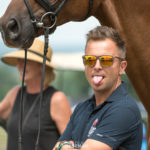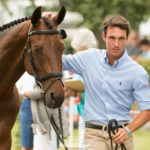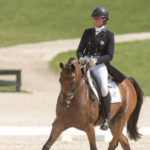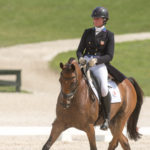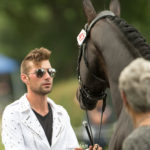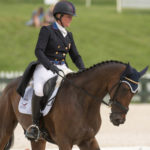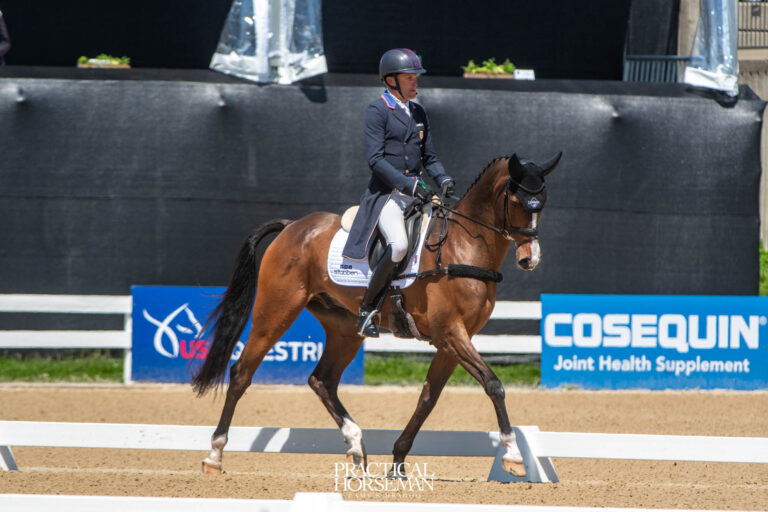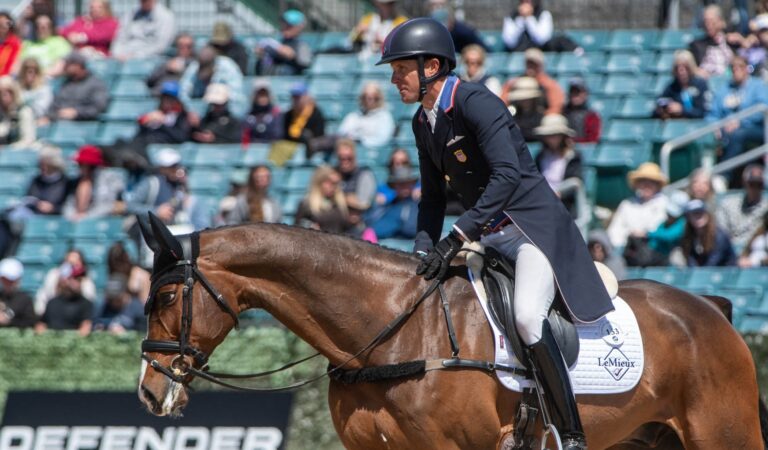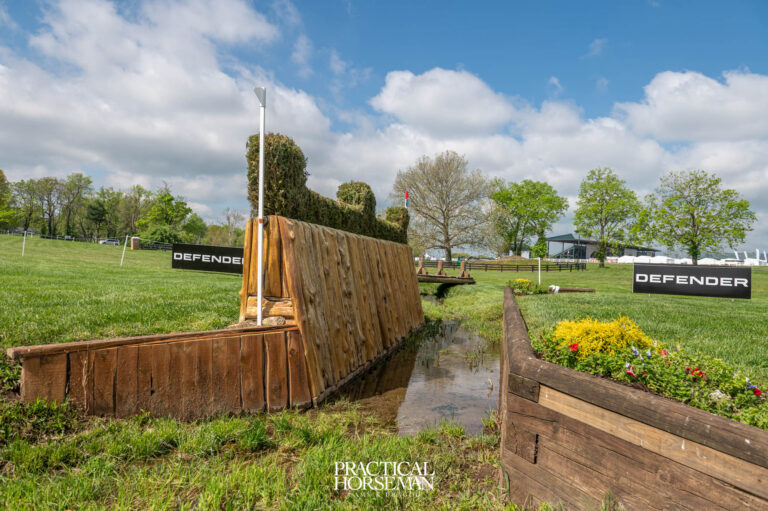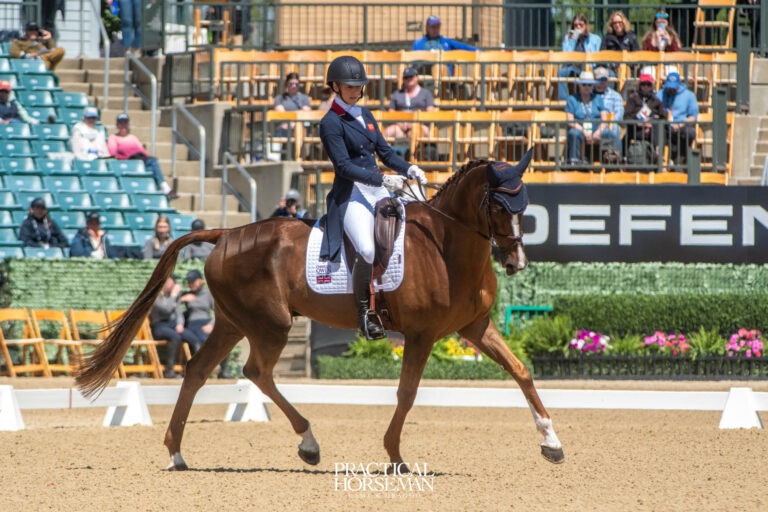 When introducing corners, the key to remember is that jumping corners is all about progression. First you need to establish the correct canter on the flat and then work over a simulated corner in the arena before heading out to jump a corner on a cross-country course. Only then will your horse jump it as confidently as Sarah Hughes’ Alcatraz, a 12-year-old Hanoverian gelding, is jumping it here.
When introducing corners, the key to remember is that jumping corners is all about progression. First you need to establish the correct canter on the flat and then work over a simulated corner in the arena before heading out to jump a corner on a cross-country course. Only then will your horse jump it as confidently as Sarah Hughes’ Alcatraz, a 12-year-old Hanoverian gelding, is jumping it here.Corner fences are a common element seen on nearly every cross-country course in America. Starting at Training level, horses and riders need to be prepared to answer the corner. When introducing riders and young horses to corners, I use the same approach each time, starting by building a simulated corner in the arena to introduce the concept and then move to jumping an actual corner on a cross-country course.
Whether you are training for dressage, show jumping or cross country, there is always a progression. You start with the basics and gradually work your way up, and it is no different when jumping corners. First, you need to have the correct seat, leg and hand aids in place, which I describe in the next section. Then you build confidence by jumping a simulated corner in the arena using a barrel and two standards, which will set you up for success when you leave the comfort zone of the arena and jump a corner on the cross-country course.
Step 1: Develop the Correct Canter
Jumping corners confidently starts with having the right canter. A corner is an accuracy test, and for these types of questions I like to tone down the between-the-fences gallop to a slower speed in the approach. You still want a forward, positive canter, but approaching at a slower pace gives your horse more time to see the fence and understand the question. Before working on the corner in the arena, practice this canter, focusing on your aids. The combination of seat, leg and hand aids you use approaching the corner will give your horse every opportunity to confidently jump it.
Step 2: Practice a Corner in the Arena
TIP >> The progression to jumping the fence as a full corner might not happen in one jump school. For the first school, you might start with the front rail angled down to the ground and a wing pole to guide the horse (see photo 3 on page 45). For the second school, you might review the first school briefly, then if your horse jumps confidently, put the pole back in the cup while still using a wing pole. For the third jump school, you can take away the wing.
Ben Hobday, a rider for the British Nations Cup team, shares a silly moment with the photographers.
Felix Vogg and Calero are the sole athletes from Switzerland.
Felix Vogg and Calero are the sole athletes from Switzerland.
Vermiculus, a half-Arabian, performed a lovely dressage test for Lauren Kieffer this afternoon, earning a 33.1. The pair are one of 5 combinations named to this year’s WEG team.
Vermiculus, a half-Arabian, performed a lovely dressage test for Lauren Kieffer this afternoon, earning a 33.1. The pair are one of 5 combinations named to this year’s WEG team.
Fresh off their win in last month’s $50,000 Devon Arena Eventing class, Chris Talley and the stallion Sandro’s Star are looking ahead to this weekend’s competition.
TIP >> Horses and riders will progress at different rates when it comes to jumping a corner in the arena. The key is to advance at a pace that builds confidence in both you and your horse. If it takes three or more jump schools to reach this point, the time spent in the arena doing your homework is worth it.
Step 3: Jump a Cross-Country Corner
WHEN IS IT TIME TO MOVE TO CROSS COUNTRY? After enough jump schools in the arena with your horse jumping the simulated corner in both directions without a wing pole—he should be jumping without any hesitation—it’s time to head out on the cross-country course. Be sure to build your simulated corner so it will resemble the same height and width of the corner in your cross-country field. If you don’t have a corner at home, try and make sure the course you trailer to has good footing and isn’t too muddy so your horse won’t slip and lose confidence as he is still learning. Also ensure that your corner is staked into the ground so it can’t move if your horse knocks it with one of his legs. When you head out to a cross-country corner, bring a pole to create a wing on the corner and have your ground person place it on the tip of the corner at approximately a 110-
degree angle like you did in the ring.
TIP >> If at any time you don’t feel confident, remember that this exercise is about progression. Continue using the wing pole in your jump schools on the cross-country course. Once you feel ready to take the next step, remove the wing pole and conquer the corner in both directions.
Fresh off their win in last month’s $50,000 Devon Arena Eventing class, Chris Talley and the stallion Sandro’s Star are looking ahead to this weekend’s competition.
WEG team member Lynn Symansky, a hometown favorite, earned a 34.7 in this afternoon’s combined test with Donner.
WEG team member Lynn Symansky, a hometown favorite, earned a 34.7 in this afternoon’s combined test with Donner.
Troubleshooting
Understand that your aids play an all-important role in successfully jumping corners. If you canter down to the corner too fast, the horse can misread the question. If you come in too weak and on a loose rein, you increase your chance of a runout.
If a runout happens, think about what happened and why. Did you approach the jump on the wrong line, maybe at too severe an angle, so your horse didn’t understand the question? Were your hands not set wide enough to create a tunnel? Were you in a galloping position as opposed to a defensive seat? Did you have both legs firmly on your horse’s sides to encourage him to go forward?
If your horse runs out while schooling corners on cross country, bring the wing pole back to return him to familiar territory he understands. It’s also a good idea to jump another fence, like a table or log, that you know your horse will be confident over before coming back to the corner. This gets his mind back to thinking about going from one side of the jump to the other.
If you horse still runs out after bringing the wing pole back, it is often easier to fix the problem in the arena as opposed to on the cross-country course. Go back to repeating the earlier steps in this exercise there. Place a wing pole on the simulated corner in the arena, drop the front rail to the ground and then start over building it back up.
About Ryan
Australian native Ryan Wood grew up in Pony Club and started competing in eventing at 8 years old. He purchased his first horse, an Australian Stock Horse named Countdown, through a local newspaper for $1,000. Ryan and Countdown moved up through the levels of eventing together, completing their first CCI**** at Adelaide when they were both 19 years old.
Ryan competed successfully throughout Australia, garnering top placings at Melbourne CCI***, Sydney CCI*** and Warwick CIC-W***. He trained with and worked for numerous top riders, including Australian eventer Guy Wallace, Olympic dressage trainer Norbert Van Laak and top champion show jumpers Ludger Beerbaum and Ernst Hofschroer.
Ryan moved to the United States in 2008 and started working for Bruce Davidson before moving to Phillip Dutton’s True Prospect Farm in Unionville, Pennsylvania. He now runs his own business out of True Prospect Farm. Since moving to the U.S. Ryan has become one of the top event riders in the country. In 2016 he won the Jersey Fresh CCI***, Bromont CCI*** and the USEA Adequan Advanced Gold Cup Final at the American Eventing Championships.
This article was originally published in the December 2017 issue of Practical Horseman.





